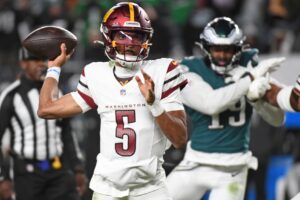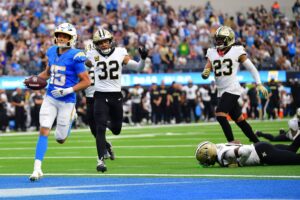For many seasons, the New Orleans Saints have boasted one of the most consistent and explosive offenses in the NFL. Many players have contributed to their high success from wide receivers Marques Colston and Brandin Cooks to tight ends Jeremy Shockey and Jimmy Graham. Of course, the leaders of the offensive attack are quarterback Drew Brees and head coach Sean Payton. Production has boosted significantly the past three seasons as Brees and wide receiver Michael Thomas have turned into the league’s most explosive duo. Can the New Orleans Saints passing offense continue to produce this season?
Questions for the New Orleans Saints passing offense in 2019
The Saints have to continue that high productivity after reaching even further in the postseason than in 2017. There are many questions regarding whether or not the Saints’ high-power passing game will hinder their potential 2020 Super Bowl run. From the outputs of the pass catchers, efficiency in the red zone and the health of Brees, the Saints have many concerns entering the 2019 NFL season.
1. Who Will Step Up as the Second-string Wide Receiver?
The Saints’ accomplishments in the passing game have been nothing short of impressive with Brees as the leader. Michael Thomas’ impact in the past three years has statistically been one of the most dominant in NFL history. In his first three campaigns, Thomas has accounted for 3,787 yards and 23 touchdowns on 321 receptions. His receptions are the most ever a wide receiver in their first three seasons. Outside of Thomas, the Saints have some trouble finding reliable targets deep down the field. Despite only playing five games a year ago due to a knee injury, slot receiver Tedd Ginn Jr. has been excellent in short-to-midrange plays in the passing since he arrived in 2016 and will continue to be so moving forward.
Last season, rookie Tre’Quan Smith was a disappointing starter with 427 yards and five touchdowns from 28 receptions. He ranked third last season in team reception yards but underperformed in big situations. Brees often threw to Thomas in double coverage situations and still managed to be highly successful. The Saints cannot afford to keep repeating this maneuver. Smith or another wide receiver must step up as the second main deep threat target. Former Tennessee Titans receiver Rishard Matthews is looking to rebound from a rough 2018 campaign after playing for two teams, signing late in the season and being put on injured reserve. Matthews is trying to return to his 2016 form where he accounted for 945 yards and nine touchdowns on 65 receptions for the Titans.
2. What Are the Expectations of the Saints’ Red Zone?
Through much of Brees’ tenure in New Orleans, the Saints’ passing offense has had above-average tight ends to provide support to their efficiency. New Orleans hasn’t had a statistically-dominate tight end since Jimmy Graham was traded to the Seattle Seahawks during the 2015 off-season. Last year, tight end Benjamin Watson was a reliable short-yardage target for Brees in a few situations. His age was an indication of why he did not account for more than two touchdowns and 400 yards. Running back Alvin Kamara is one of the league’s most dangerous players with his explosive versatility as a runner and pass catcher. Kamara accounted for 709 receiving yards and four touchdowns on 81 receptions. Overall, the Saints ranked fourth in the league in touchdowns accounted for in the red zone with a 68.4 percent scoring percentage on drives.
With Watson retired from the league (before joining back with New England), the Saints needed a reliable starting tight end, leading to one of the underrated signings this off-season was in former Oakland Raiders tight end Jared Cook. Last season, Cook accounted for 896 yards and six receiving touchdowns on 68 receptions. These were all the highest of his ten-year career in the league as he earned his first Pro Bowl selection. Having a fresh tight end coming off his best season coupled with a dynamic back like Kamara should give New Orleans a huge boost to an already-talented red zone offense. Having a more reliable short-range target will relieve some pressure off Brees in his progressions and Thomas when he potentially gets double covered.
3. Is Teddy Bridgewater Ready to Take Over if Drew Brees Suffers an Injury?
Even with its immense potential, the greatest threat to the Saints’ offense is injury–mild or severe–to Drew Brees. New Orleans’ passing offense is built around the high-velocity arm and leadership of Brees. Its explosive offense would drop off with Brees injured on the sidelines. The Saints have not drafted a young, potential starting quarterback in the past few NFL Drafts. They did, however, resign former Minnesota Vikings starting quarterback Teddy Bridgewater to another one-year contract. While this seems temporary, both sides are open to getting another deal done if Brees decides to retire after his contract expires at the end of the 2019 season.
Bridgewater only played in one significant season since his major ACL tear just before the 2016 season. New Orleans did give him significant time to get back into playing shape as he started in Week 17 when the Saints already clinched the home-field advantage. Last season, Bridgewater passed for 14 completions out of 23 attempts for 118 yards, one touchdown and one interception. He will be tested more as a potential future starter for the Saints in this upcoming season. Head coach Sean Payton doesn’t want to force him into the starting lineup with an injury to Brees.
Main Photo:
Embed from Getty Images






